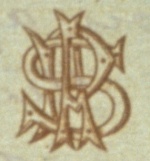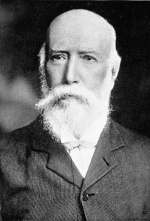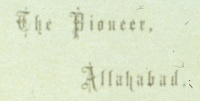Alfred Percy Sinnett: Difference between revisions
| Line 81: | Line 81: | ||
During his return to England, in 1883, he published his second book, [[Esoteric Buddhism (book)|''Esoteric Buddhism'']], which had a huge impact on the Theosophical Movement. | During his return to England, in 1883, he published his second book, [[Esoteric Buddhism (book)|''Esoteric Buddhism'']], which had a huge impact on the Theosophical Movement. | ||
His other works | His other works, in order of publication: | ||
*''''' | *'''''Karma: A Novel'''''. London: Chapman and Hall, 1885. Chicago: The Yogi Publication Society, 1911. Reprinted by Mokelumne Hill, CA: Health Research, Mokelumne, 1968. | ||
*'''''United''''', 1886 | *'''''Occult Essays''''', 1886. London: Theosophical Publishing Society, 1905 | ||
*'''''United: A Novel''''', London G. Redway, 1886. | |||
*'''''The Rationale of Mesmerism'''''. London K. Paul, Trench, Trübner, 1892. Boston: Houghton, Mifflin and Co., 1892. | *'''''The Rationale of Mesmerism'''''. London K. Paul, Trench, Trübner, 1892. Boston: Houghton, Mifflin and Co., 1892. | ||
*'''''Nature's Mysteries, and How Theosophy Illuminates Them'''''. 1901. Revised and reprinted by Los Angeles, CA: Theosophical Publishing House, 1918. | |||
*'''''The Growth of the Soul: a Sequel to "Esoteric Buddhism"'''''. 2nd edition, enlarged. London: Theosophical Publishing Society, 1905. | *'''''The Growth of the Soul: a Sequel to "Esoteric Buddhism"'''''. 2nd edition, enlarged. London: Theosophical Publishing Society, 1905. | ||
*'''''Married by Degrees''''', 1911. A play. | *'''''Married by Degrees''''', 1911. A play. | ||
*''''' | *'''''In the Next World: Actual Narratives of Personal Experiences by Some Who Have Passed On''''', London: Theosophical Pub. Society, 1914. | ||
*'''''The Spiritual Powers and the War'''''. London: Theosophical Publishing Society, 1915. | *'''''The Spiritual Powers and the War'''''. London: Theosophical Publishing Society, 1915. | ||
*'''''Collected Fruits of Occult Teaching'''''. Philadelphia, PA: J. P. Lippincott, Philadelphia, 1920. | *'''''Collected Fruits of Occult Teaching'''''. Philadelphia, PA: J. P. Lippincott, Philadelphia, 1920. | ||
*''''' | *'''''Tennyson An Occultist; As His Writings Prove'''''. London: Theosophical Publishing House, 1920. New York: Haskell, 1972. | ||
*'''''The Early Days of Theosophy in Europe'''''. Theosophical Publishing House Ltd, London, 1922. Available online at [http://theosophical.ca/books/EarlyDaysOfTheosophyInEurope,The_APSinnett.pdf Canadian Theosophical Association]. Published posthumously, this gives an account of how the Sinnetts came to invite HPB to Simla; how APS left ''The Pioneer''; the use of the term [[Brotherhood]]; [[Anna Bonus Kingsford]]; HPB's time in Europe; the Gebhard family; and many other aspects of early TS history. Manuscript published after death. | |||
*'''''The Early Days of Theosophy in Europe'''''. Theosophical Publishing House Ltd, London, 1922. Available online at [http://theosophical.ca/books/EarlyDaysOfTheosophyInEurope,The_APSinnett.pdf Canadian Theosophical Association]. Published posthumously, this gives an account of how the Sinnetts came to invite HPB to Simla; how APS left ''The Pioneer''; the use of the term [[Brotherhood]]; [[Anna Bonus Kingsford]]; HPB's time in Europe; the Gebhard family; and many other aspects of early TS history. | *'''''Super-Physical Science'''''. London: Theosophical Publishing House, 1924. Manuscript published after death. | ||
*'''''Super-Physical Science'''''. London: Theosophical Publishing House, 1924. | *'''''Autobiography of Alfred Percy Sinnet'''''. London: Theosophical History Centre, 1986. Manuscript published after death. Note: the surname is spelled with one "t". | ||
He was editor for these works: | He was editor for these works: | ||
Revision as of 18:05, 8 October 2013
Alfred Percy Sinnett (January 18, 1840, London - June 26, 1921) was an English author, journalist, and Theosophist, who played an important part in growth of the Theosophical Society during its first generation.
Life and career
Alfred Percy Sinnett was born on January 18, 1840, in London, Middlesex. His father was a journalist and his mother a writer who had published numerous books. Alfred's father died when he was only five years old. His childhood was one of deprivations; his widowed mother Jane having to sustain three boys and three girls by writing newspaper articles and translations. Jane's only financial help was her older daughter Sophia, age 22, who was a teacher. Young Sinnett did poorly at school and left it without finishing his studies. He eventually obtained a position as assistant and sub-editor of The Globe, an evening newspaper.
On April 6, 1870, Sinnett married his wife Patience Edensor, probably in the London area. By that time he had become an editorial writer for The Evening Standard. He is listed in the 1871 England Census at age 31, as a Journalist, born in Middlesex. His wife Patience is listed as age 27, and her mother Clarissa Edenson, a "Landowner", as living with them.
In 1872 Mr. George Allen, the proprietor of the Anglo-Indian newspaper The Pioneer, offered him the editorship. He resigned his previous position and left for India, arriving at Allahabad toward the end of the year. During these first years in India he had a good income, a good social life, and professional recognition.
On May 16, 1877, Mrs. Sinnett gave birth to a son, Percy Edensor Sinnett, generally called "Dennie".
In 1879 Mr. Sinnett met the founders of the Theosophical Society and began a life-long association with them and the organization. He became Vice President of the Theosophical Society from 1880-8, and was also in that role from 1895-1907, and from 1911-21.
By the end of 1882, and mainly because of his involvement with Theosophy, Sinnett was dismissed as the Editor of The Pioneer.
Late February 1883 he and his wife left Allahabad for England, stopping by first in Madras. There, he is engaged in writing his Esoteric Buddhism. He plans to return to India to publish a new Journal, The Phoenix, as soon as capital has been made available, something that finally does not happen.
On March 30 the Sinnetts sail for Europe on the P. & O. steamer SS Peshawar, reaching England on April 26. Upon his arrival he attracted the interest of the London Spiritualists, members of the Psychical Research Society, and Theosophists such as the Arundales and the Gebhards. At this time, his second book, Esoteric Buddhism, was published.
In April/May 1883 Sinnett became a member of the London Lodge. In autumn 1883, the Lodge separated into two parts, one following Sinnett, the other following Anna Bonus Kingsford. He became the President of the Lodge in January 1885.[1] At this time, he makes the acquaintance of Charles Webster Leadbeater, who after having read his Esoteric Buddhism became interested in Theosophy.
In 1886 the proprietors of The Pioneer decided to establish a London office, a task that was entrusted to Sinnett. He was in charge of this office for a couple of years until the proprietor himself took over.
In 1889, Sinnett asked C. W. Leadbeater to come back to England from Ceylon to tutor his son Denny, now a boy of 12, and George Arundale. Leadbeater agreed and brought with him one of his pupils Curuppumullage Jinarājadāsa.
In 1907 the President-Founder Henry Steel Olcott died. Sinnett, as Vice-President, became invested with the authority of the Presidential office until Annie Besant was elected as the second international President of the Theosophical Society (Adyar).
On May 11, 1908, his son Dennie died of tubercolosis, at 31 years of age. Sinnett's wife Patience died of cancer the same year, at midnight on November 9.[2]
Mr Sinnett died on June 26, 1921, at the age of 81.
Work at The Pioneer
In 1872, Sinnett became editor of The Pioneer, owned by Sir George William Allen.[3] In the eleven years of his editorship, the little paper grew into the leading Anglo-Indian daily newspaper of the day.[4]
Soon after Sinnett's meeting with the Founders he established a correspondence with the Mahatmas. Through this correspondence and his involvement with Theosophy his attitude about the natives and the Indian affairs began to change, becoming more supportive.
In 1882 Clive Rattigan purchased The Pioneer from Allen and the new proprietors communicated to Mr. Sinnett that at the end of his engagement, in November of that year, the newspaper would no longer need his services. Sinnett wrote of Rattigan:
He had been from the first intensely unsympathetic with my interest in the occult development ..., but for my connection with Theosophy it would have been unlikely that my connection with the Pioneer would have been disturbed at this period. There was some friction between myself and the new proprietors, but my success as writer had become fairly conspicuous and the friction such as it was would not have been enough to break the tie. But again both my wife and I had grown tired of the Indian life and wished to be back in England. It seemed just possible that the savings of our time in India, plus journalistic work at home, would enable us to live there in moderate comfort, so that we contemplated my resignation of the Pioneer editorship as a step we might be inclined to take. The parting therefore was neither strained nor unfriendly, and for many years after my return to England I continued to write articles of various kinds for the paper in India.[5]
Evidence that the relationship with the paper remained cordial is shown that around 1891, he was able to help C. W. Leadbeater obtain employment in the London office of The Pioneer.[6]
The Mahatma Letters

In 1875, during a visit to London, Sinnett became interested in Spiritualism.
In 1879 Sinnett heard that H. P. Blavatsky and Col. H. S. Olcott have arrived at Bombay, India. Assuming they were Spiritualists, he wrote them a letter on February 25 expressing his desire to become acquainted with them, and his willingness to publish any information which they liked to give him about their mission in India. On December 2 of that year the Founders visited Mr and Mrs Sinnett at their house in Allahabad and remained there as their guests for six weeks.[7]
In 1880 Helena Blavatsky and Henry Steel Olcott paid a second visit to the Sinnetts, this time at their summer-home in Simla. Many wonderful phenomena took place at the time, which Mr. Sinnett described in his book The Occult World. Although the phenomena were performed in front of witnesses and in a careful way, Sinnett wanted to design one that could be "really complete in their details and leave no opening for the suggestion even of imposture."[8] It was then that the famous correspondence with the Mahatmas began. In Sinnett's words:
One day, therefore, I asked Madame Blavatsky whether if I wrote a letter to one of the Brothers explaining my views, she could get it delivered for me. I hardly thought this was probable, as I knew how very unapproachable the Brothers generally are; but as she said that at any rate she would try, I wrote a letter, addressing it " to the Unknown Brother," and gave it to her to see if any result would ensue. It was a happy inspiration that induced me to do this, for out of that small beginning has arisen the most interesting correspondence in which I have ever been privileged to engage.[9]
The "Unknown Brother" that answered was the one known as Koot Hoomi, and from this grew a correspondence that took place from 1880 to 1885. The letters that Sinnett and his friend A. O. Hume received were published in 1923 under the title The Mahatma Letters to A. P. Sinnett.
Most of the letters were transmitted by psychic means and precipitated by different chelas such as H. P. Blavatsky, Damodar K. Mavalankar, and others.
On October 19, 1880, Mr. Sinnett received an astral visit by Master K.H.. About four years later William Q. Judge asked Mr. Sinnett about this, and reported the following:
He was lying in his bed in India one night, when suddenly awakening, he found K. H. standing by his bed. He rose half up, when K. H. put his hand on his head, causing him to fall at once back on the pillow. He then, he says, found himself out of his body, and in the next room, talking to another adept whom he describes as an English or European, with light hair, fair, and of great beauty. This is the one Olcott described to me in 1876 and called by name ------ [ Serapis ] . . . He described K. H. as looking then not exactly like the picture now in his possession, but with some resemblance to it.[10]
As to why the Mahatmas agreed to enter in correspondence with him and Mr. Hume, the Master K.H. wrote:
Your sagacity, my kind friend, will have suggested long ago, that it is not so much because of your combined personal virtues — though Mr. Hume I must confess, has run up a large claim since his conversion — or my personal preferences for either of you, as for other and very apparent reasons. Of all our semi-chelas you two are the most likely to utilise for the general good the facts given you. You must regard them received in trust for the benefit of the whole Society; to be turned over, and employed and re-employed in many ways and in all ways that are good. If you (Mr. Sinnett) would give pleasure to your trans-Himalayan friend, do not suffer any month to pass without writing a Fragment, long or short for the magazine, and then, issuing it as a pamphlet — since you so call it.[11]
The Phoenix
After Sinnett was dismissed from The Pioneer in 1883, the Master K. H. made an effort to engage Sinnett in organizing a newspaper called the The Phoenix, supported by Indian capital. This newspaper sought to help in raising the social and economic condition of the Indian masses, their sense of self-respect, and their standing in the eyes of the world.
Sinnett left for England hoping to return to India for this project, but after considerable efforts to raise the funds needed the enterprise had to be abandoned for lack of support from the Indians.
Writings
In March 1881 the Sinnetts went to England for a holiday, and Mr. Sinnett published his first Theosophical book, The Occult World. It described the occult phenomena produced by Mme. Blavatsky in India. The book produced a profound impact but generated tense relations within part of the Anglo-Indian society, and eventually led to his dismissal as Editor of The Pioneer.
During his return to England, in 1883, he published his second book, Esoteric Buddhism, which had a huge impact on the Theosophical Movement.
His other works, in order of publication:
- Karma: A Novel. London: Chapman and Hall, 1885. Chicago: The Yogi Publication Society, 1911. Reprinted by Mokelumne Hill, CA: Health Research, Mokelumne, 1968.
- Occult Essays, 1886. London: Theosophical Publishing Society, 1905
- United: A Novel, London G. Redway, 1886.
- The Rationale of Mesmerism. London K. Paul, Trench, Trübner, 1892. Boston: Houghton, Mifflin and Co., 1892.
- Nature's Mysteries, and How Theosophy Illuminates Them. 1901. Revised and reprinted by Los Angeles, CA: Theosophical Publishing House, 1918.
- The Growth of the Soul: a Sequel to "Esoteric Buddhism". 2nd edition, enlarged. London: Theosophical Publishing Society, 1905.
- Married by Degrees, 1911. A play.
- In the Next World: Actual Narratives of Personal Experiences by Some Who Have Passed On, London: Theosophical Pub. Society, 1914.
- The Spiritual Powers and the War. London: Theosophical Publishing Society, 1915.
- Collected Fruits of Occult Teaching. Philadelphia, PA: J. P. Lippincott, Philadelphia, 1920.
- Tennyson An Occultist; As His Writings Prove. London: Theosophical Publishing House, 1920. New York: Haskell, 1972.
- The Early Days of Theosophy in Europe. Theosophical Publishing House Ltd, London, 1922. Available online at Canadian Theosophical Association. Published posthumously, this gives an account of how the Sinnetts came to invite HPB to Simla; how APS left The Pioneer; the use of the term Brotherhood; Anna Bonus Kingsford; HPB's time in Europe; the Gebhard family; and many other aspects of early TS history. Manuscript published after death.
- Super-Physical Science. London: Theosophical Publishing House, 1924. Manuscript published after death.
- Autobiography of Alfred Percy Sinnet. London: Theosophical History Centre, 1986. Manuscript published after death. Note: the surname is spelled with one "t".
He was editor for these works:
- Incidents in the Life of Madame Blavatsky: Compiled from Information Supplied by Her Relatives and Friends. London: G. Redway, 1886. London: Theosophical Pub. Society, 1913.
- Besant, Annie, and Charles W. Leadbeater. Occult Chemistry: Clairvoyant Observations on the Chemical Elements. Revised edition. London : Theosophical Pub. House, 1919. The Editor's Preface stated: "I have contributed an entirely new preliminary chapter ... From the beginning of chapter III to the end the book in its present form is simply a reprint of the original edition."
Published lectures include:
- "The Pyramids and Stonehenge". London, 1893. Second edition - London: Theosophical Publishing Society, 1901. Third edition - London: Theosophical Pub. House, 1958. Reprinted in 1970. Originally delivered as two lectures before the Theosophical Society, London, in 1892-93.
Online resources
Articles
- Alfred Percy Sinnett at Theosopedia
Additional resources
- A. P. Sinnett's Natal Chart at Astrodienst
Notes
- ↑ Alfred Percy Sinnett, Autobiography of Alfred Percy Sinnett (London: Theosophical History Centre, 1986), 31.
- ↑ Alfred Percy Sinnett, Autobiography of Alfred Percy Sinnett (London: Theosophical History Centre, 1986), 53-55.
- ↑ "Sir George William Allen KCIE," [1]
- ↑ Combined Chronology of The Mahatma Letters - Preface
- ↑ Alfred Percy Sinnett, Early Days of Theosophy in Europe. (Theosophical Publishing House Ltd, London, 1922),38-39. Available online at Canadian Theosophical Association.
- ↑ Alfred Percy Sinnett, Early Days of Theosophy in Europe. (Theosophical Publishing House Ltd, London, 1922),110-111. Available online at Canadian Theosophical Association.
- ↑ Alfred Percy Sinnett,The Occult World, 42. Available at WikiSource.
- ↑ Alfred Percy Sinnett, The Occult World (London: Theosophical Publishing House, 1969), 81.
- ↑ Alfred Percy Sinnett, The Occult World (London: Theosophical Publishing House, 1969), 82.
- ↑ William Q. Judge, Letters That Have Helped Me, (Los Angeles:The Theosophy Company, 1946), 196.
- ↑ Vicente Hao Chin, Jr., The Mahatma Letters to A.P. Sinnett in chronological sequence No. 68 (Quezon City: Theosophical Publishing House, 1993), 202-203.

